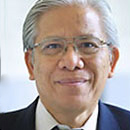My grandchildren Elizabeth, Maya, and Jack are my pride and joy. Elizabeth and Jack were born in Boston and are growing up in the U.S. with my daughter Helen and her American husband Dan Flagg. Maya is what Vancouverites call “born and bred in Vancouver” living with my son George and his Canadian wife Brenda Jamer.
None of my grandkids have been to the Philippines yet but I dream of their eventual visit there. I would like to show them how beautiful the country is. They should see their Lola’s hometown of Pila, Laguna, with its verdant rice fields turning golden when the palay ripens and the towering coconut trees that compete with Mounts Banahaw and Makiling in touching the ever blue skies. I would also take them to my hometown of Apalit to get a glimpse of Mount Arayat and see the Pampanga River where I learned how to swim as a boy.
A country with more than 7,000 islands, the Philippines has inviting beaches everywhere. I’ll fly the kids to Iloilo (where Eleanor’s mother came from), Bohol and Cebu to enjoy white sandy beaches, calm blue waters, sweeping ocean views and luxurious world-class resorts. The kids would love watching the colourful sunrise and sunset after sun-drenched days. I would also show them Iloilo’s beautiful Miag-ao church, a UNESCO Heritage site, and other churches built during the Spanish times.
In Manila, I’ll take the kids to the Luneta Park, enjoy a sumptuous breakfast of agahang magbubukid with them at the Manila Hotel, and then board the double-decker sightseeing bus for a leisurely ride along Roxas Boulevard. I’ll point out all interesting landmarks like the Jose Rizal monument, the Baywalk, the Rizal Memorial Stadium where their Lola first learned how to swim, the old Malate church next to the Aristocrat restaurant where we used to celebrate special occasions, the Central Bank of the Philippines, and all those five-star hotels with fantastic ocean views. After this, I’ll take them to Intramuros for a brief history lesson on the Philippines under Spain. I’ll show them Fort Santiago and the old San Agustin church within the walled city.
On a Sunday I’ll take the kids to the Farmers Market in Cubao and let them sample a variety of tropical fruits like atis, balimbing, caimito, camachile, chico, duhat, macopa, and siniguelas. I will point out fresh vegetables that grow only on Philippine soil. I will show them colourful and fragrant flowering plants, unique shrubs and beautiful wild orchids. I’ll buy them souvenir handicrafts made from bamboo and coconuts. We’ll go five-star hotel hopping for lunch, merienda and dinner so they can see that the services and amenities in these hotels are far better than their counterparts in other parts of the world.
Between meals, the kids and I will shop in malls like the SM Mall of Asia, Mega Mall on EDSA, the Glorietta in the Ayala Center, and the Trinoma north of Manila. Or we can take in a movie in Eastwood City where the seats recline like Lazyboy lounge chairs. Or I’ll take them to a typical Filipino restaurant serving traditional Filipino foods cooked the way they should be as in Abe’s in the Greenbelt and Barasoain on Amorsolo Street in Makati. We’ll attend shows at the Cultural Center of the Philippines for a taste of Filipino creativity in song, dance, painting and the various visual arts.
To get a feel of the pulsating everyday life in Manila, I’ll take the kids on an air conditioned “Hop on Hop off” tour of the city with touristy stops for shopping, leisure and entertainment in Manila, Makati and Pasay City. This will be an exhausting tour so after a hectic day I’ll take them to a spa for pampered rest and relaxation including a soothing massage for their tired feet and a refreshing cool drink of calamansi, guayabano or buko juice for a taste of something new.
For a sight they will see only in the Philippines, I’ll fly the kids to Baguio and from there take an air-conditioned motor coach for a breath-taking tour of the Banaue rice terraces high in the Cordillera mountain range. Eleanor and I first visited these rice terraces in the early 1960s when the drive up the mountain from Baguio was difficult and dangerous on narrow serpentine roads. Now there are air conditioned buses and even a luxury hotel in Banaue for tourists wanting to see this wonderful UNESCO heritage site.
I’m very proud of these rice terraces because they show the ingenuity of our Filipino forebears who tamed and reshaped their environment to enable them to grow rice for their subsistence. Scholars believe that rice has been planted on these terraces for about 2,000 years. The rice terraces are prominent national symbols of the Philippines because they were built by Filipinos by hand without foreign assistance or influence. There is nothing else in the Philippines that can top the beauty and the grandeur of these terraces.
I love the natural and man-made beauty of the Philippines like its mountains, forests and beach resorts; its fruits, flowers and home-cooked foods. I am proud of its history and our forefather's fight for freedom against foreign invaders. Most of all, I’m proud of the people’s adaptability, creativity, generosity, optimism, perseverance, resilience, resourcefulness and warmth. I hope my grandkids will observe these traits during their visit especially when they spend a weekend with relatives in Pila, Laguna, to attend the town fiesta. Surrounded by caring and gracious family and friends there, they will clearly understand and appreciate their rich and unique blend of Asian-Western heritage.



